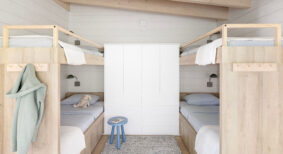Over the last decade, hardwood floor trends have been influenced by leading designers and flooring manufacturers with custom capabilities. Three current trends in hardwood flooring include: wider boards, textured surfaces, and natural grey toned patinas.
Wider
While a 6” width was once considered wide plank, 7” is now common with 8” widths readily available. The popularity of these wide boards is increasing, and their use is expanding. In the past, wide boards were primarily used in rustic settings, but they are now being used to bring a natural element into contemporary spaces. Many may think that wide plank floors would appear out of place in modern or traditional homes, based on their width alone. Like large format tiles, there are benefits to going wider. A major benefit is a reduction in the amount of bevels across the floor. The increase from 6” to 8” wide planks will reduce the amount of bevels across a room by 25 per cent, decreasing the choppy or “busy” appearance seen on floors with narrower boards. This also applies to plank lengths, where longer average lengths further reduce the amount of bevels.
Special considerations need to be taken when installing wide plank floors. With planks over 6” wide, partial glue down or full trowel glue down methods should be used. Partial glue down is used with a plywood subfloor where a bead (aka “lazy-s”) of adhesive is applied down the back of the plank before it is nailed in place. Full trowel glue down is used with plywood or concrete subfloors and uses a trowel applied adhesive with 100 per cent coverage. Not all adhesives are created equally, so it is imperative to follow each adhesive manufacturer’s instructions for the product being installed. Each adhesive will have a specific trowel size or spread rate depending on the construction (solid or engineered) and thickness of the flooring being installed. Too much or not enough adhesive could negatively affect the installation, and ultimately the lifespan, of the floor. With either of these methods, it is important to ensure that the adhesive being used is approved for use by the hardwood manufacturer, as this will be one of the first items looked at in the event of an installation failure.
Texture
In recent years, the popularity of wire brushed and hand scraped floors have steadily increased, and now account for the majority of hardwood flooring purchased today. The more textured the surface, the less likely it is that dents or light scratches will be noticed, increasing its appeal for use in an active household.
The “piano-top” smooth floors no longer dominate the marketplace as they tend to show dust, foot-prints, and dents. To produce wire brushed floors, rotating brushes are used to remove the softer spring wood, leaving behind the denser and harder summer wood, revealing the wood grains inherent texture and depth.
Many lower end “hand-scraped” floors are manufactured using machines, often resulting in patterns that are nearly replicated on each board. This repeating pattern is why many consumers today are turned off when they hear this term. On some higher-end floors, the hand-scraping is actually done by hand, allowing craftsman to work with the natural elements found on each plank. This results in a timeless look, free from the unnatural patterns created by machines. Due to the negative connotations associated with the term “hand scraped”, those manufacturers producing authentically hand scraped material are now instead referring to their flooring as having a “hand worked” surface.
Grey tone
Lastly, an emerging trend in hardwood flooring is the use of a process called fuming to achieve a natural grey patina. With advancements in technology, achieving a grey floor is no longer limited to applying a stain or glaze, which often results in an artificial look. Manufacturers are now able to reproduce traditional fuming processes in a controlled environment with predictable results.
The appeal of the fuming technique, specifically when done on White Oak, is the ability to achieve a naturally aged look without emphasizing the grain of the wood. Fuming can be done to varying degrees – the more the floor is fumed, the darker and richer the wood becomes. After fuming, additional treatments can be applied to enhance colours and add depth within the wood.
The use of wide and textured flooring has been increasing over the last decade. These trends, with the addition of the natural grey patina of a fumed white oak, are a combination that will be appreciated for years to come.
Brandon Merchant is the Pacific Northwest territory manager for Creative at Home Inc, the exclusive manufacturers of the Antique Impressions line of handcrafted hardwood flooring. Contact him at Brandon@creativeathome.com







